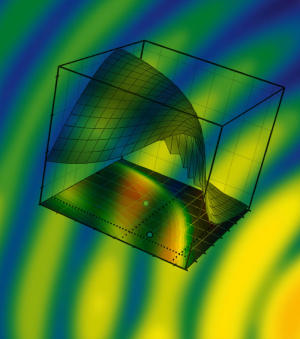
A team of researchers from the IMP Vienna together with collaborators from the Vienna University of Technology established a new microscopy technique which greatly enhances resolution in the third dimension. In a simple set-up, the scientists used the translation of position information of fluorescent markers into color information. Overcoming the need for scanning the depth of a sample, they were able to generate the precise 3D information at the same speed as it would take to acquire a 2D image. The general principle of this innovative approach can be used for broader applications and is published online in the PNAS Early Edition this week.
For many disciplines in the natural sciences it is desirable to get highly enlarged, precise pictures of specimens such as cells. Depending on the purpose of an experiment and the preparation of the sample, different microscopy-techniques are used to analyze small structures or objects. However, a drawback of most current approaches is the need to scan the depth of a sample in order to get a 3D picture. Especially for optically sensitive or highly dynamic (fast moving) samples this often represents a serious problem. Katrin Heinze and Kareem Elsayad, lead authors of the PNAS publication, managed to circumvent this difficulty during their work at the IMP.
Precise images of sensitive and dynamic samples
Elsayad, who was part of a research team led by Katrin Heinze at the IMP, used fluorescence microscopy for his experimental set-up. The principle of fluorescence microscopy -- now a common tool in biomedical research labs -- is as follows: Fluorescent dyes, so-called fluorophores, are turned on by light of a certain wavelength and, as a consequence, "spontaneously" emit light of a different wavelength. Elsayad designed a thin biocompatible nanostructure consisting of a quartz microscope slide with a thin silver film and a dielectric layer. The IMP-scientist then labeled the sample -- fixed or live cells -- with a fluorescent dye and placed it above the coated slide.
Elsayad explains in simple terms how the biological imaging then took place: "The measured emission spectrum of a fluorescent dye above this substrate depends on its distance from the substrate. In other words, the position information of a collection of fluorophores is translated into color information, and this is what we were measuring in the end." With this elaborate method, only one measurement is needed to determine the fluorophore distribution above the substrate, with a resolution -- in the direction away from the substrate -- down to 10 nanometers (1/100.000th of a millimeter). "I believe that the beauty of our method is its simplicity. No elaborate set-up or machines are required to achieve this high resolution. Once the sample is placed on the substrate, which can be mass produced, a confocal microscope with spectral detection is all that is needed," Heinze points out.
Simple method, big potential
The novel technique was already successfully tested by Elsayad and Heinze. Together with collaborators at the Institute of Molecular Biotechnology (IMBA) of the Austrian Academy of Sciences, they used it to study paxillin, a protein important for cell adhesion, in living cells. The scientists also visualized the 3D dynamics of filopodia, small cell protrusions made of bundled actin-filaments that move very quickly and have a high turnover-rate during cell migration.
Originally developed for a single fluorescent marker, the new method can be adapted for others as well."There are numerous possibilities for further development and additional applications of the technique," Elsayad points out. "From optical readout on chips to make faster computers, to more efficient DNA sequencing methods." The novel technique patented by the IMP has already attracted a lot of interest from several big optical companies.

 Previous page
Previous page Back to top
Back to top







